
Photo illustration: Single Pass Radiator vs Double Pass Radiator
A single pass radiator allows coolant to flow through one continuous path, enabling faster heat dissipation with simpler design. Double pass radiators force coolant to travel through two separate passes, increasing contact time and improving heat transfer efficiency in high-performance systems. Choosing your radiator depends on balancing cooling needs with system complexity and space constraints.
Table of Comparison
| Feature | Single Pass Radiator | Double Pass Radiator |
|---|---|---|
| Design | One continuous flow path | Two flow passes through core |
| Cooling Efficiency | Moderate heat dissipation | Higher heat dissipation due to extended flow |
| Flow Rate | Higher flow rate, less resistance | Lower flow rate, increased flow resistance |
| Size | Compact, simpler design | Larger size, more complex core |
| Cost | Lower manufacturing cost | Higher manufacturing cost |
| Application | Standard cooling needs, light to medium vehicles | High-performance engines, heavy-duty vehicles |
| Maintenance | Easy to clean and repair | More complex, requires careful maintenance |
Introduction to Radiator Types
Single pass radiators feature coolant flowing through the radiator core in one continuous path, facilitating efficient heat dissipation with a straightforward design. Double pass radiators redirect the coolant for a second pass through the core, increasing heat transfer surface area and improving cooling performance in high-demand applications. Choosing between single pass and double pass radiators depends on engine cooling requirements, system complexity, and available space in the cooling system layout.
What is a Single Pass Radiator?
A Single Pass Radiator is a type of heat exchanger where the coolant flows through the radiator core only once before returning to the engine, ensuring a straightforward and efficient cooling process. This design typically features a single row of tubes, allowing for quick heat dissipation but with less surface area compared to double pass radiators. Single Pass Radiators are often preferred in systems requiring lower pressure drops and simpler construction, making them suitable for light-duty vehicles and applications with moderate cooling requirements.
How Does a Double Pass Radiator Work?
A double pass radiator works by directing the hot coolant through the radiator core twice, increasing heat transfer efficiency compared to a single pass radiator where coolant flows only once. This design forces coolant to travel through the length of the radiator, then loop back through a second passage, allowing for more surface area exposure to cooling air and improved thermal dissipation. As a result, double pass radiators provide enhanced cooling performance essential for high-performance engines or heavy-duty applications.
Key Differences: Single Pass vs Double Pass
Single Pass Radiators allow the coolant to flow through the radiator core once, resulting in faster heat dissipation but lower thermal efficiency compared to Double Pass Radiators, which direct the coolant through the core twice for improved heat exchange. Single Pass systems are typically lighter and less complex, making them suitable for applications requiring quick temperature regulation. Double Pass Radiators, with their extended flow path, provide enhanced cooling performance, ideal for high-heat scenarios where maintaining lower engine temperatures is critical.
Cooling Efficiency Comparison
Single pass radiators direct coolant through the radiator once, resulting in faster heat dissipation and lower coolant temperature at the outlet but potentially less contact time for heat transfer. Double pass radiators force the coolant to flow through the radiator core twice, increasing heat transfer surface contact and improving cooling efficiency by up to 15-20% compared to single pass designs. The enhanced thermal exchange in double pass radiators leads to better temperature regulation in high-performance engines or systems requiring intensive cooling.
Installation Considerations
Single pass radiators require straightforward installation with one inlet and one outlet, simplifying pipework and reducing labor costs. Double pass radiators need plumbing that routes water through both sides of the radiator, which involves more complex pipe arrangements and increased installation time. Proper planning for pipe routing and space constraints is essential to ensure efficient flow and optimal heat distribution in double pass radiator setups.
Performance Benefits in Various Applications
Single Pass Radiators offer enhanced heat transfer efficiency by allowing coolant to flow straight through the core, making them ideal for high-performance automotive and industrial cooling where rapid temperature reduction is critical. Double Pass Radiators improve heat dissipation by directing coolant through the core twice, increasing the contact time with cooling fins and enhancing thermal performance in heavy-duty machinery and HVAC systems. Choosing between Single Pass and Double Pass Radiators depends on application-specific needs for cooling efficiency, flow rate, and space constraints.
Cost Implications and Value
Single Pass Radiators typically offer lower initial costs due to simpler design and reduced material usage, making them budget-friendly for basic heating needs. Double Pass Radiators, though more expensive upfront, provide enhanced heat output and efficiency, resulting in potential long-term savings on energy bills. Evaluating cost implications with considerations of heating requirements and energy consumption ensures optimal value between single and double pass radiator options.
Maintenance and Longevity
Single pass radiators feature a simpler design with water flowing through once, leading to easier maintenance due to fewer internal components and reduced risk of blockages. Double pass radiators allow water to flow through two separate channels, enhancing heat exchange but requiring more frequent cleaning to prevent sediment buildup that can affect efficiency. Longevity depends on water quality and regular upkeep, with single pass systems generally offering longer service life due to lower internal pressure and simpler construction.
Which Radiator is Right for Your Needs?
Single pass radiators feature a straightforward design where the coolant flows through the radiator only once, making them ideal for systems requiring moderate cooling efficiency and simpler maintenance. Double pass radiators direct the coolant through the radiator twice, enhancing heat dissipation and improving cooling performance, which suits high-performance engines or heavy-duty applications. Choosing between single pass and double pass radiators depends on your engine's cooling requirements, space constraints, and desired efficiency for optimal thermal management.
 caratoz.com
caratoz.com